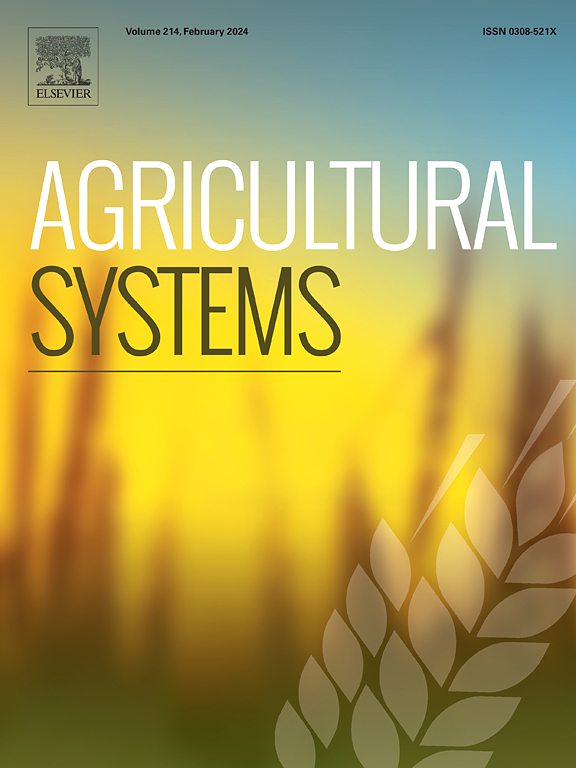Strategies to reduce CH4 and N2O emissions whilst maintaining crop yield in rice–wheat system under climate change using SPACSYS model
IF 6.1
1区 农林科学
Q1 AGRICULTURE, MULTIDISCIPLINARY
引用次数: 0
Abstract
CONTEXT
Climate change is projected to threaten food security and stimulate greenhouse gas emissions. Hence, adaptation measures without sacrificing food production are required.
OBJECTIVE
To assess possible consequences of rice–wheat system under climate change and to propose possible practices for mitigation.
METHODS
The Soil-Plant-Atmosphere Continuum SYStem (SPACSYS) model was tested using datasets from long-term experiment (1991–2019) assessing the impact of different fertilisation on crop production, crop nitrogen (N) content, soil organic carbon (SOC) stock, methane (CH4) and nitrous oxide (N2O) emissions in a Cambisol under rice–wheat system. The validated SPACSYS was then used to investigate the possible mitigation strategies from 2024 to 2100 under climate change scenarios (SSP1–2.6 and SSP5–8.5) and the baseline scenario and mitigation management scenarios, i.e., (i) reduced N application rate by 20 % (RNA), (ii) the introduction of mid-season drainage (MSD) and (iii) integrated management combining RNA with MSD (IM).
RESULTS AND CONCLUSIONS
Results showed that SPACSYS performed effectively in simulating yield and N content in grain and straw, SOC stock and CH4 and N2O emissions. Scenarios analysis elucidated that RNA would not decrease grain yields for either rice or wheat under the two climate change scenarios. Compared to the baseline scenario, low level of climate change scenario considering the CO2 fertilisation effects (SSP1–2.6_CO2) may benefit wheat yield (28 %) and had no effects on rice yield. In contrast, under the SSP5–8.5 scenario, whether CO2 fertilisation effects are considered or not, both rice and wheat yield could face great loss (i.e., 11.8–29.9 % for rice, 8.3–19.4 % for wheat). The winter wheat would not be suitable for planting in the distant future (2070–2100) due to the incomplete vernalisation caused by warming. The switching from winter wheat to spring wheat from 2070 onward could avoid the yield loss by 8.3–19.4 %. Climate change could decrease SOC sequestration rate. Under future climate change scenarios, IM could significantly decrease CH4 emissions by 56 % and N2O emissions by 24 %, as such reducing the net global warming potential by 69 % compared to no adaptation. Our simulations suggest that under climate change, crop switching in rice–wheat system combining integrated mitigation practices is possible to mitigate global warming and maintain crop production.
SIGNIFICANCE
Our results underscore the significance of integrated adaptation of agricultural systems to climate change.

基于SPACSYS模型的气候变化下水稻-小麦系统减少CH4和N2O排放同时保持作物产量的策略
气候变化预计将威胁粮食安全并刺激温室气体排放。因此,需要在不牺牲粮食生产的情况下采取适应措施。目的评估气候变化对水稻-小麦系统可能产生的影响,并提出可能的缓解措施。方法利用1991-2019年长期试验数据集,对土壤-植物-大气连续系统(SPACSYS)模型进行检验,评估不同施肥对水稻-小麦系统下Cambisol作物产量、作物氮(N)含量、土壤有机碳(SOC)储量、甲烷(CH4)和氧化亚氮(N2O)排放的影响。然后,利用验证的SPACSYS研究了气候变化情景(SSP1-2.6和SSP5-8.5)、基线情景和减缓管理情景下2024 - 2100年可能的减缓策略,即(i)减少20%的施氮量(RNA)、(ii)引入季中排水(MSD)和(iii) RNA与MSD (IM)相结合的综合管理。结果与结论结果表明,SPACSYS在模拟粮食和秸秆产量、氮含量、有机碳储量以及CH4和N2O排放方面具有较好的效果。情景分析表明,在两种气候变化情景下,RNA均不会导致水稻和小麦减产。与基线情景相比,考虑CO2施肥效应(SSP1-2.6_CO2)的低水平气候变化情景可能有利于小麦产量(28%),而对水稻产量没有影响。相比之下,在SSP5-8.5情景下,无论是否考虑CO2施肥效应,水稻和小麦的产量都可能面临巨大损失(即水稻减产11.8 - 29.9%,小麦减产8.3 - 19.4%)。由于气候变暖导致冬小麦春化不完全,在遥远的未来(2070-2100年)不适合种植。从2070年起由冬小麦转为春小麦,可避免8.3% ~ 19.4%的产量损失。气候变化会降低有机碳的固存率。在未来的气候变化情景下,与不适应相比,IM可以显著减少56%的CH4排放和24%的N2O排放,从而使全球变暖净潜能值降低69%。我们的模拟表明,在气候变化条件下,水稻-小麦系统的作物转换结合综合减缓措施是可能的,可以减缓全球变暖并保持作物生产。我们的研究结果强调了农业系统对气候变化的综合适应的重要性。
本文章由计算机程序翻译,如有差异,请以英文原文为准。
求助全文
约1分钟内获得全文
求助全文
来源期刊

Agricultural Systems
农林科学-农业综合
CiteScore
13.30
自引率
7.60%
发文量
174
审稿时长
30 days
期刊介绍:
Agricultural Systems is an international journal that deals with interactions - among the components of agricultural systems, among hierarchical levels of agricultural systems, between agricultural and other land use systems, and between agricultural systems and their natural, social and economic environments.
The scope includes the development and application of systems analysis methodologies in the following areas:
Systems approaches in the sustainable intensification of agriculture; pathways for sustainable intensification; crop-livestock integration; farm-level resource allocation; quantification of benefits and trade-offs at farm to landscape levels; integrative, participatory and dynamic modelling approaches for qualitative and quantitative assessments of agricultural systems and decision making;
The interactions between agricultural and non-agricultural landscapes; the multiple services of agricultural systems; food security and the environment;
Global change and adaptation science; transformational adaptations as driven by changes in climate, policy, values and attitudes influencing the design of farming systems;
Development and application of farming systems design tools and methods for impact, scenario and case study analysis; managing the complexities of dynamic agricultural systems; innovation systems and multi stakeholder arrangements that support or promote change and (or) inform policy decisions.
 求助内容:
求助内容: 应助结果提醒方式:
应助结果提醒方式:


